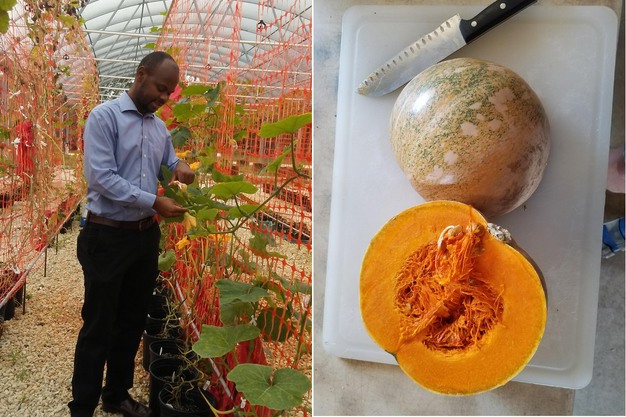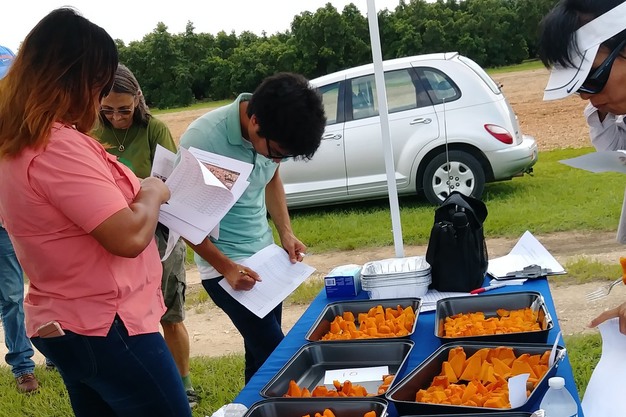If you have eaten at Caribbean, Central or South American restaurants, you might know a specialty pumpkin called calabaza. Traditionally used as a key ingredient in stews, soups, sides, breads and even desserts, it is the center of the plate for a team of University of Florida scientists hoping the gourd is ripe for a new industry in the Southeast.
After two years of research, Geoffrey Meru, a UF/IFAS vegetable geneticist and his team at the UF/IFAS Tropical Research and Education Center in Homestead hope to release the potential of calabaza.
 Dr. Meru says calabaza is easy to grow and is almost pest-free as a crop.
Dr. Meru says calabaza is easy to grow and is almost pest-free as a crop.
“It is a nutritional powerhouse with much versatility that produces little waste because you can use the flesh, the seeds and even the rind,” said Meru. “It is easy to grow, almost pest-free and an excellent crop you can use in rotation with others.”
Currently, most of the pumpkin seed consumed in the United States is imported, creating the need to breed high-yielding and nutritious accessions that are locally adapted to various zones in the country. To meet the current and projected domestic demand for pumpkin seed, growers must have access to pumpkin cultivars with optimized seed yield, size and nutrition.
Because growing the calabaza is adapted to Florida’s tropical climate with minimal irrigation requirements, the team has been researching its qualities as a sustainable crop to grow commercially in Florida, Georgia, Alabama and Puerto Rico.
 Dr. Meru recently held a field day that displayed cultivars from the greenhouse.
Dr. Meru recently held a field day that displayed cultivars from the greenhouse.
Thanks to a $399,999 grant from the U.S. Department of Agriculture Southern Sustainable Agriculture Research and Education (USDA-SSARE), the research is at a critical stage. They have developed a variety of breeding lines and tested 20 varieties with four growers, two in Florida, one in Alabama and one in Georgia.
They have also conducted a socioeconomic analysis to determine consumer product preferences such as color, flavor and price, and gathered data to assess grower and grocer preferences of cultivars.
Growers and grocers are looking at size, yield and how consumers prefer to select calabaza at the store, whether sliced in quarters or halves, chopped or available whole.
The most recent ethnic market analysis for calabaza in Florida was estimated at a value of $5 million, while its total imports into the United States are estimated at $30 million.
The team has also focused on whether calabaza provides the right combination of profit, wider consumer demand and usefulness for a variety of industries.
 For more information:
For more information:
Lourdes Mederos
University of Florida
Tel: +1 (954) 242-8439
[email protected]
https://ifas.ufl.edu/
